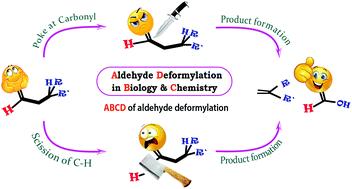A comprehensive insight into aldehyde deformylation: mechanistic implications from biology and chemistry
Abstract
Aldehyde deformylation is an important reaction in biology, organic chemistry and inorganic chemistry and the process has been widely applied and utilized. For instance, in biology, the aldehyde deformylation reaction has wide differences in biological function, whereby cyanobacteria convert aldehydes into alkanes or alkenes, which are used as natural products for, e.g., defense mechanisms. By contrast, the cytochromes P450 catalyse the biosynthesis of hormones, such as estrogen, through an aldehyde deformylation reaction step. In organic chemistry, the aldehyde deformylation reaction is a common process for replacing functional groups on a molecule, and as such, many different synthetic methods and procedures have been reported that involve an aldehyde deformylation step. In bioinorganic chemistry, a variety of metal(III)-peroxo complexes have been synthesized as biomimetic models and shown to react efficiently with aldehydes through deformylation reactions. This review paper provides an overview of the various aldehyde deformylation reactions in organic chemistry, biology and biomimetic model systems, and shows a broad range of different chemical reaction mechanisms for this process. Although a nucleophilic attack at the carbonyl centre is the consensus reaction mechanism, several examples of an alternative electrophilic reaction mechanism starting with hydrogen atom abstraction have been reported as well. There is still much to learn and to discover on aldehyde deformylation reactions, as deciphered in this review paper.

- This article is part of the themed collection: Catalysis & biocatalysis in OBC


 Please wait while we load your content...
Please wait while we load your content...